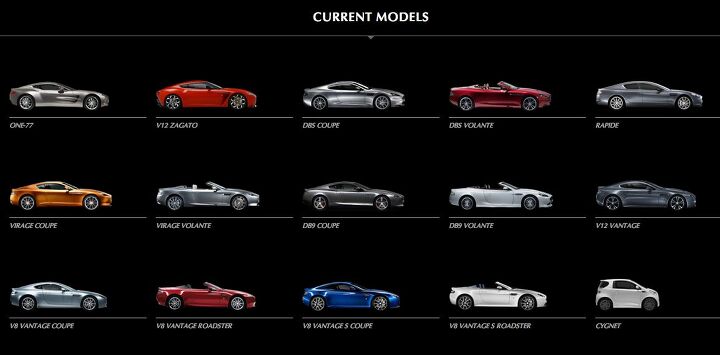Ask The Best And Brightest: Is Aston-Martin A Bit Old Hat?
Ian Callum, designer of the Aston-Martin DB7 (along with the new Jaguars and numerous other gorgeous things) is a really, genuinely nice guy. But even nice guys have their limits, and having seen his groundbreaking Aston design evolve with the morphological dynamism of a sturgeon over the last 17 years, Callum appears to have reached his. Bloomberg reports:
It’s still that same old basic design,” Ian McCallum, who designed the DB9 and is now design director at Tata Motors Ltd. (TTMT)’s Jaguar Land Rover unit, said in a July 27 interview. “Some will argue that if it ain’t broke, don’t fix it. But you do get to a time when you have to move on.”
Sadly, there are a few factual distractions to deal with here before we dig further into Aston’s predicament. First of all, though a Scot, the man’s name is Callum, not McCallum. Also, it’s not clear how much of the DB9 was styled by Callum, and how much was finished by his successor, Heinrik Fisker. Clear? OK, back to Aston…
The models are starting to have a slight whiff of Sunday dinner being used in sandwiches later in the week. It leaves the impression of a company stretching itself as far as it can. In the industry that they operate in, with their competitors, they really need to be cutting edge.
The stuck-in-time, across-the-line styling is part of the problem. A platform that was the talk of the enthusiast committee in 2003 is the other part. A resurgent, Callum-designed Jaguar lineup doesn’t help. Plus, split-the-difference “new” models certainly don’t mask the scent of death well, nor do Toyota rebadges. The prosecution rests.
And what of the defense? Well, all Astons may look the same and be technologically outdated, but they’re still pretty damn good looking. Also,
“All the projects that we are doing have to make a profit,” Chief Executive Officer Ulrich Bez, 66, told journalists at the company’s Gaydon headquarters. “We can’t afford a project that is just a marketing tool.”
The strategy has pushed up the average price of Aston Martin cars 49 percent to 104,000 pounds last year from 70,000 pounds in 2007, the company said at the July 6 briefing.
By recycling technology and using engines from Ford, Aston Martin can keep costs and development times down. That’s secured Aston Martin a profit margin of about 20 percent, nearly double Mercedes’s 10.7 percent return on sales in the second quarter.
Twice the profit margin of Mercedes? That’s nice, but how long will it last when
Daimler AG (DAI), the parent of Mercedes-Benz, plans to spend about 5 billion euros ($7.1 billion) this year on research and development. That’s more than eight times the Gaydon, England-based company’s revenue of 509 million pounds ($830 million) for the 12 months ended March 31.[?]
The sad irony of Aston’s flirtation with over-the-hill, passé status is that it still hasn’t held an IPO, but is waiting for “the right window” (i.e. when the market comes back). By the time that happens, could it be too late for the last independent global British sportscar brand?
More by Edward Niedermeyer
Latest Car Reviews
Read moreLatest Product Reviews
Read moreRecent Comments
- Kjhkjlhkjhkljh kljhjkhjklhkjh I own my house 100% paid for at age 52. the answer is still NO.-28k (realistically) would take 8 years to offset my gas truck even with its constant repair bills (thanks chevy)-Still takes too long to charge UNTIL solidsate batteries are a thing and 80% in 15 minutes becomes a reality (for ME anyways, i get others are willing to wait)For the rest of the market, especially people in dense cityscape, apartments dens rentals it just isnt feasible yet IMO.
- ToolGuy I do like the fuel economy of a 6-cylinder engine. 😉
- Carson D I'd go with the RAV4. It will last forever, and someone will pay you for it if you ever lose your survival instincts.
- THX1136 A less expensive EV would make it more attractive. For the record, I've never purchased a brand new vehicle as I have never been able to afford anything but used. I think the same would apply to an EV. I also tend to keep a vehicle way longer than most folks do - 10+ years. If there was a more affordable one right now then other things come to bear. There are currently no chargers in my immediate area (town of 16K). I don't know if I can afford to install the necessary electrical service to put one in my car port right now either. Other than all that, I would want to buy what I like from a cosmetic standpoint. That would be a Charger EV which, right now, doesn't exist and I couldn't afford anyway. I would not buy an EV just to be buying an EV. Nothing against them either. Most of my constraints are purely financial being 71 with a disabled wife and on a fixed income.
- ToolGuy Two more thoughts, ok three:a) Will this affordable EV have expressive C/D pillars, detailing on the rocker panels and many many things happening around the headlamps? Asking for a friend.b) Will this affordable EV have interior soft touch plastics and materials lifted directly from a European luxury sedan? Because if it does not, the automotive journalists are going to mention it and that will definitely spoil my purchase decision.c) Whatever the nominal range is, I need it to be 2 miles more, otherwise no deal. (+2 rule is iterative)


































Comments
Join the conversation
The DB9 and V8 vantage are sculpture with a soundtrack. I can see why they're doing what they're doing, after all how many 911 variants are there? It is as close to my perfect vehicle as exists (I use the nav on my phone anyways).
Yeah, Callum was heavily involved with the DB7, but it is grossly unfair to Keith Helfet to suggest that it was Callum's design. http://www.aronline.co.uk/blogs/2011/07/23/concepts-and-prototypes-jaguar-xj4142/